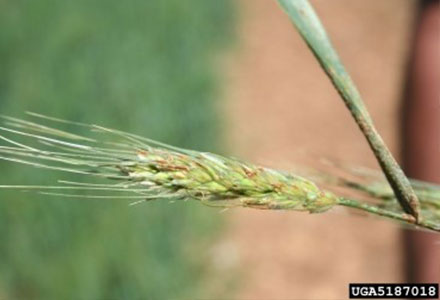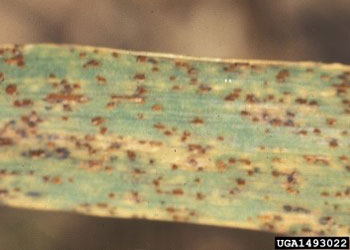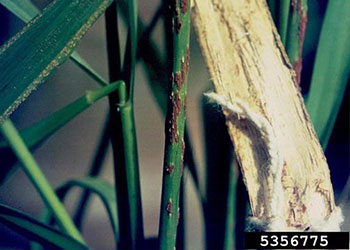PLANT PEST

Sabine Werres BBA, Braunschweig, Germany, PaDIL
Ug99 wheat stem rust
Exotic to Australia
Features: A fungal pest causing wheat stem rust that could cause huge losses in grain crops
Where it's from: Parts of Africa and Middle East
How it spreads: Importation of infected plants or spores
At risk: Grain (wheat, barley, oats and rye)
Keep it out
Wheat stem rusts are fungal diseases that damage cereal crops around the world. Most Australian crops have been bred to be resistant to stem rusts, but have no resistance to this particular type, known as P. graminis f. sp. tritici pathotype Ug99.
Ug99 therefore poses a high biosecurity risk to the grains industry in Australia because it would infect plants, ruin crops and see some of our trade partners reject our exports. The rust affects wheat, barley, oats and rye.
The disease spreads from plant to plant by spores, which are small, light and can survive for several days. In addition to being spread by wind, spores can easily attach to clothing, machinery and tools allowing movement and spread between farms and regions. They can also be brought across the world on personal items of travellers.
It is very unlikely that this wheat stem rust would be eradicated if it made it into Australia’s crops. The disease could even cause total failure of Australia’s valuable grain crops.
Importing goods
To keep Ug99 wheat stem rust out of Australia, never ignore Australia’s strict biosecurity rules.
Import shipments may need to be treated and certified, so before you import, check our Biosecurity Import Conditions system (BICON).
What to look for
The symptoms of Ug99 wheat stem rust are identical to other wheat stem rusts in Australia.
- Oval or rectangular blisters running along stems and leaves.
- After a couple of days blisters break open to reveal a mass of rust coloured spores.
- If stem rust is detected on any type of wheat that is thought to be resistant to wheat stem rust, samples should be sent for testing.


Where to look
Importers
The mostly likely way that Ug99 would make it to Australia is in infected grain, or plant material or on machinery that has not been cleaned properly.
It can also spread on clothing, shoes and personal items if people have been grain growing regions in infected parts of Africa and the Middle East.
Travellers
It is important that people and luggage, clothing and shoes are clean and free of soil or plant material when entering Australia from Africa and the Middle East.
Growers and grain handlers
Growers are advised to check crops every 7 to 10 days for signs of anything unusual, since early detection is vital for this easily spread disease.
Walk through cropping paddocks in a ‘W’ shape checking five plants at 10 different locations.
If you visit places overseas that have Ug99 wheat stem rust, be sure to clean clothes and boots before returning home.
Protect your farm from biosecurity risks, practice good on-farm biosecurity and regularly monitor your fields.
What to do
If you find wheat stem rust in a resistant variety of cereal crop:
- mark the area
- take a photo
- do not disturb infected plants (this may be as simple as closing the doors on a shipping container or preventing access to a paddock).
